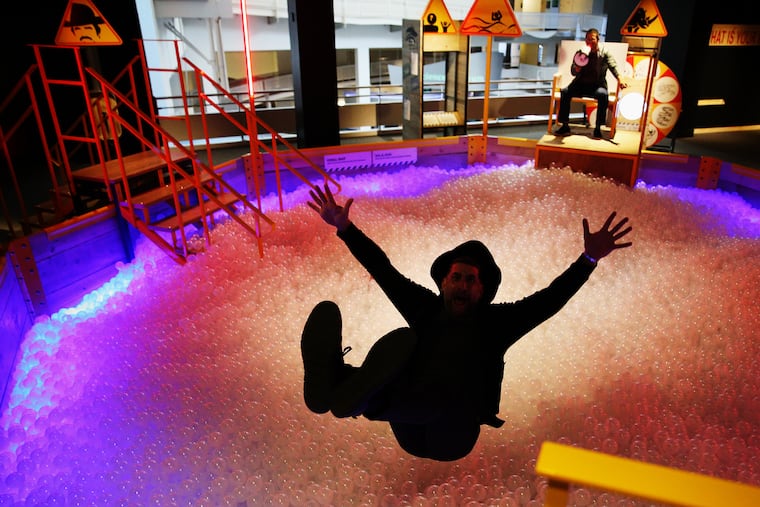Franklin Institute prepares for Worst Case Scenario
The home-grown exhibition, opening Saturday, is based on the wildly popular book series from Philly's own Quirk Books.

There are probably worse situations you can face than going to work, although all may not agree.
For Larry Dubinski, president of the Franklin Institute, it’s generally not a problem.
Take the other morning. The appropriately business-suited Dubinski wandered into the institute’s special exhibition area, where his staff was putting the finishing touches on the next big exhibition, The Worst-Case Scenario: Survival Experience, based on the wildly popular (10 million copies sold) series created by Philadelphia’s own Quirk Books, and written by Philadelphians Joshua Piven and David Borgenicht (founder and CEO of Quirk).
What could go wrong?
Before he could wonder how he might escape from quicksand or survive an avalanche, Dubinski found himself engulfed in an enormous pit filled with thousands of translucent plastic balls. More balls kept cascading in like — an avalanche!
He didn’t panic. For one thing, Piven and Borgenicht were foundering right there with him, adventurers to the wild world beyond the pits at Chuck E. Cheese. As mounds of balls rose around them, they began to slowly backstroke to shore. The balls kept rising. Dubinski disappeared momentarily and then re-emerged, deploying a modest freestyle and inching his way to safety.
Meanwhile, Piven and Borgenicht flailed. Spectators gasped. Did they want a lifeline? No. They butterflied their way to solid ground.
» READ MORE: Mutter Museum will mark the great flu pandemic with a new exhibit
Dubinski, now on dry, stable land, said, “You definitely feel consumed. There’s no doubt about it. It’s deep and it’s a little unnerving.” That said, he added, “I’m excited about the exhibition. It’s great to see something like this come together — all Philadelphia-conceived and executed. It’s become a great way to talk about survival skills, curiosity, thinking. And it’s fun.”
Worst Case opens at the Franklin Institute Saturday for a run through April 19. It’s the first exhibition the institute has created and built from scratch since Your Brain in 2014. Geoffrey M. Curley + Associates put it all together in Mount Laurel and Minneapolis studios. It coincides with the Worst Case Scenario book series’ 20th anniversary.
Lest anyone think that flopping about in a ball pit and laughing like crazy has little to do with science, listen up. Every one of the scenarios cooked up by Piven and Borgenicht finds its escape strategies from the advice of scientists and experts who know what they’re talking about.
You just have to plan and follow the advice. (As in: Lie flat in quicksand; use a freestyle motion to stay atop snow.)
How do you avoid a shark attack? For one thing, don’t wear shiny jewelry (reflected light resembles fish scales).
How do you escape the clutches of a python? One way is to stun the snake by knocking it in the head (a flashlight or big rock might be useful), then unwrapping it. Do not remain still and play dead — the snake will probably continue to constrict. (Pro tip: The python will likely not seek to consume you right away.)
The exhibit also explains what to do if you’re attacked by swans. (Expert answer: Run away.) A game of upside-down tic-tac-toe suggests how to keep calm and focused when your car has upended after bashing off the road and rolling down a hillside.
» READ MORE: Philadelphia museum shows: Climate crisis, Notorious RBG, shark-bite survival, and ‘Spit Spreads Death’ at the Mütter
Skills are taught. Visitors can master lock-picking. They can practice how to hop from one moving train car to another. (Hint: Do not stand up straight!) They can climb a wall and escape a fire or perhaps a pool of alligators. (Your choice.)
Borgenicht says Quirk gets mail from readers who’ve escaped to safety — thanks to expert advice provided in Worst Case.
“Most recently, there was a woman in Australia who had to perform a tracheotomy on her boyfriend,” he said. “She remembered how to do it from having read our book.” (This particular scenario is not replicated at the Franklin Institute.)
The expert advice offered in the book and in the exhibit draws on a wide range of expertise and study — animal behavior, building engineering, weather, geology, fire dynamics —and many are useful, depending on what’s bearing down on you.
“The wonderful thing about this is that there are actual people behind these scenarios and there’s actual science,” said Abby Bysshe, the institute’s vice president of business development.
Mark Harmon, the institute’s director of operations, safety, and security, is a featured expert, for instance. Before the Franklin Institute, he helped calm riled-up music fans at the Tower Theater. He also worked the Vet during the Army-Navy game when a railing collapsed, hurling cadets to the ground.
Harmon has some simple advice for dealing with hostile crowds: Ignore angry words, he said, and don’t ask questions.
Has he been faced with difficult situations at the Franklin Institute?
“Mitt Romney visited one day.” Harmon said after a moment’s thought. “There were some protesters. That was probably the worst thing.”
ON EXHIBIT
The Worst-Case Scenario: Survival Experience
Oct. 19-April 19, 2020, at the Franklin Institute, 271 North 21st St.
Tickets: Adults, $30; children ages 3-11, $26 (includes museum admission). Discounted evening tickets Thursday-Saturday after 5 p.m.: Adults, $20; children $15 (does not include general museum admission).
Information: 215-448-1200 or fi.edu